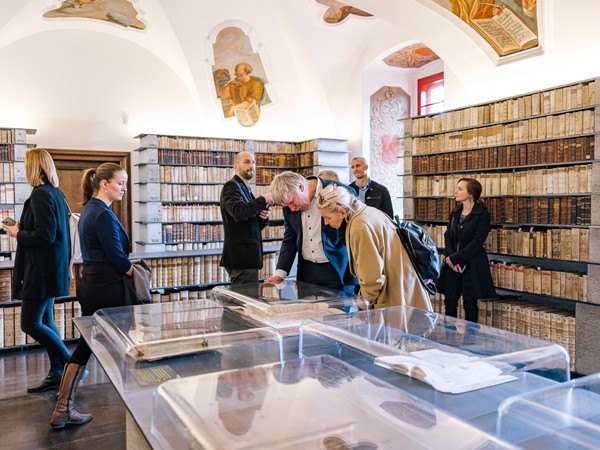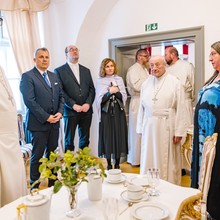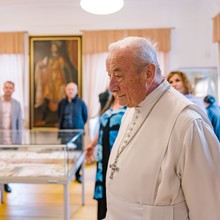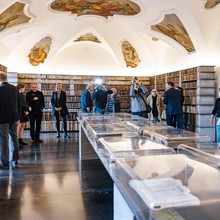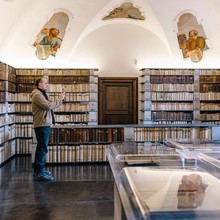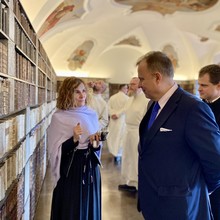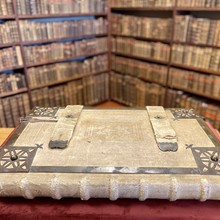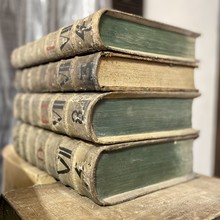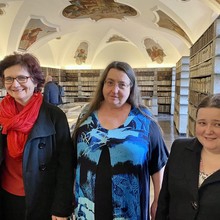A treasure stored in hundreds of banana boxes. Old books, covered with a layer of dust, many mildewed. Piles of volumes, some published more than five centuries ago, right after the invention of the printing press. This is how the historic library of the Želiv Monastery looked, until recently. But since March of this year, the rare books are back in their rightful place. After decades of material suffering, they have returned to their shelves in the newly restored areas of the original monastery library. Students of archiving and history at Palacký University had a large role in this – arranging the books under their teachers’ tutelage took six years.
The history of mankind has shown many times that the most important chapters are written into our fate and our books, almost in parallel. This has been so since the time of the revolutionary invention of Johann Gutenberg, for the printing press changed the world forever, making it possible to distribute ideas and information en masse. The dark events in our history have been accompanied by the destruction of human lives along with books, burnt in an attempt to stifle uncomfortable ideas by erasing memory. The Želiv Monastery has always been one of those places which did not escape those dark moments in our history. It is thus almost a miracle that its book collection, tended and expanded for centuries by the Premonstratensians, has been preserved to this day.
The monastery’s history dates all the way back to 1139. It has experienced many turbulent moments in its nine centuries. It was afflicted by several fires, repeatedly occupied by Hussites and other armies, the monks had to deal with epidemics, natural catastrophes, and governmental disfavour. After the communist coup in February 1948, the monastery was dissolved as part of the government’s anti-church and monastery campaign, and due to its remote location, it was used instead as an internment camp for priests and monks, then closed in February 1956. In 1950, its furnishings were removed, and its books went to the Museum of Czech Literature’s collection at Strahov Monastery in Prague. “In the second half of the twentieth century, the monastery was used as a psychiatric clinic and rehabilitation centre for alcoholism. The callous complex management literally devastated this rare historic monument,” added the monastery’s current abbot, Tadeáš Róbert Spišák. He remembers how he came to the monastery twenty years ago and guided visitors through the refectory – the monks’ common dining hall: “I sighed that there was a library on the floor above us, a place for spiritual nourishment, but sadly, closed. Under the communists, the furniture had been burnt, and the books lay about in piles,” said Abbot Spišák, commenting on the unfortunate situation when although the books had been returned from Strahov, the collection was incomplete, uncatalogued, and disorganised.
Attempts to return the library to its original appearance and previous function began to take a specific form six years ago, when UP Faculty of Arts (UP FA) students began coming to the monastery for a practical summer course in archiving. The difficult work was led by UP FA History Department teachers Jana Oppeltová, Ema Šimková, and Věra Slavíková for the entire duration. “We also do field work with our students at other institutions in Bohemia and Moravia. We’ve been going to Želiv Monastery since 2018, always with a group of fifteen to twenty students. Our work there was quite difficult. We had to move the books twice, so every one of the books has passed through our hands at least thrice. In terms of their weight, it would be like moving three and a half elephants,” said Jana Oppeltová with a laugh.
Joining the history students were students of music history and musicology. Together, they arranged the historic books, numbered them, and partly catalogued them. In autumn of last year, the books were transferred to their new shelves over several long weekends. The modern shelving was designed by the Šépka architectural design firm. “It’s a system of concrete supports and metal shelving, and the concrete was poured in place, using stones and gravel from the Želivka River. We wanted to inscribe the place into the architecture. The whole assembly was made self-standing so we did not have to anchor it to the historic building construction in any way. In the centre of the room is a great table – an 8-metre metal surface – where the most valuable books are presented in thirteen glass-covered cases. The intention was to evoke the feeling of a banquet table, for beneath the library is the monastery dining hall,” described architect Jan Šépka.
The reconstructed and sensitively furnished areas of the original library are decorated with frescoes from the 18th century. During its ceremonial reopening last spring, UP Rector Martin Procházka was in attendance. “Želiv Monastery is one of the most beautiful and important monuments in the country. I’m proud that our students and teachers had a role in its restoration, taking part in saving the cultural heritage of our nation. I think that this is a fine example of how our students manage to make practical use of their knowledge and skills. And what is especially gratifying to me is the fact that here we have a very good example of the applicability of the humanities in society,” said the UP rector.
Želiv Monastery has been a national cultural monument since 2010; last year 17,000 visitors toured the complex. While the library is not part of the tour, it is accessible to researchers and the professional public. It is only open to visitors on special occasions, for it is part of the cloister, a place where only monks are allowed. “A monastery cannot function without books. The Želiv library was meant to be a reflection of the world, which is why it has works written mainly in German, Latin, and Czech from the most diverse fields in addition to theology. We were able to restock the library with 25,000 books published before 1860. These include medieval and Baroque manuscripts and even several incunabula – books printed before 1500. For students, it is truly something special when they first get such ancient and rare books into their hands,” noted Oppeltová.
In addition to the newly restored library, Želiv Monastery also opened the newly renovated spaces of the ancient prelature – the abbot’s residence – before the start of this year’s tourist season. “We are very grateful here for the cooperation of Dr Jana Oppeltová, who wrote the exhibition brochure, and with her colleagues from the Palacký University Faculty of Arts and from the Hroznata Academy at Teplá Monastery for its splendid installation,” added Spišák. The ancient prelature is now part of the monastery tour, and the newly-installed exhibition acquaints visitors with archaeological findings and the abbot’s lodgings as they looked at the start of the 20th century, including the bedroom, study, dining room, salon, private chapel, library, and monastery museum. “I would like to thank Palacký University, its employees and students, from the bottom of my heart. Without their efforts, dedication, expertise, and remarkable enthusiasm, we never would have accomplished this. And above all, we never would have achieved the return of these historic volumes to their rightful place after almost seventy years,” the abbot added.
Since 2018, more than a hundred UP FA students have taken part in restoring Želiv Monastery’s historic library. UP FA Department of History students and teachers travel to other places in Bohemia and Moravia, including the Cistercian Monastery in Osek near Duchcov in the Ore Mountains foothills, the Premonstratensian Monastery in Teplá near Mariánské Lázně (Marienbad), and the Diocesan Library at the bishopric in Litoměřice.
